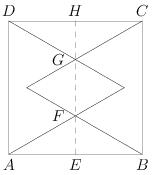Difference between revisions of "2012 AMC 10B Problems/Problem 14"
Mr doudou14 (talk | contribs) (→Solution) |
Mr doudou14 (talk | contribs) (→Solution) |
||
| Line 22: | Line 22: | ||
<math>2\times\frac{\sqrt{3}}{4}(2\sqrt{3}-2)^2 = 8\sqrt{3} - 12</math> | <math>2\times\frac{\sqrt{3}}{4}(2\sqrt{3}-2)^2 = 8\sqrt{3} - 12</math> | ||
| − | Thus, answer choice <math>D</math> is correct. | + | Thus, answer choice <math>\boxed{D}</math> is correct. |
==See Also== | ==See Also== | ||
Revision as of 19:30, 15 October 2017
Problem
Two equilateral triangles are contained in square whose side length is ![]() . The bases of these triangles are the opposite side of the square, and their intersection is a rhombus. What is the area of the rhombus?
. The bases of these triangles are the opposite side of the square, and their intersection is a rhombus. What is the area of the rhombus?
![]()
Solution
Observe that the rhombus is made up of two congruent equilateral triangles with side length equal to GF. Since AE has length ![]() and triangle AEF is a 30-60-90 triangle, it follows that EF has length 1. By symmetry, HG also has length 1. Thus GF has length
and triangle AEF is a 30-60-90 triangle, it follows that EF has length 1. By symmetry, HG also has length 1. Thus GF has length ![]() . The formula for the area of an equilateral triangle of length s is
. The formula for the area of an equilateral triangle of length s is ![]() . It follows that the area of the rhombus is:
. It follows that the area of the rhombus is:
![]()
Thus, answer choice ![]() is correct.
is correct.
See Also
| 2012 AMC 10B (Problems • Answer Key • Resources) | ||
| Preceded by Problem 13 |
Followed by Problem 15 | |
| 1 • 2 • 3 • 4 • 5 • 6 • 7 • 8 • 9 • 10 • 11 • 12 • 13 • 14 • 15 • 16 • 17 • 18 • 19 • 20 • 21 • 22 • 23 • 24 • 25 | ||
| All AMC 10 Problems and Solutions | ||
The problems on this page are copyrighted by the Mathematical Association of America's American Mathematics Competitions. 










